
CoolFish
Publications
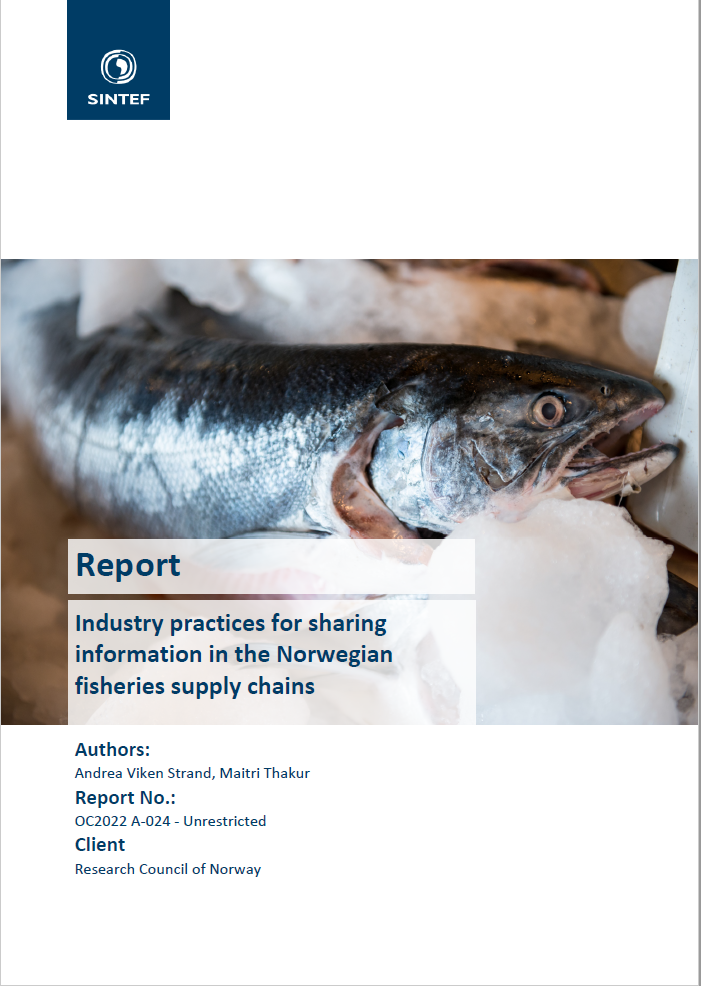
Paper:
Industry practices for sharing sustainability information in the Norwegian fisheries supply chains
- Sustainability and traceability of food products have received increased attention due to food safety, consumer demand on knowledge of the origin of their food and reducing food fraud.
- Most Norwegian fishing vessels capture detailed data on the catch and quality of fish electronically. This information is automatically reported to the authorities while most information regarding the quality and sustainability is not communicated further down the supply chain.
- Significant data gaps include information on fuel and energy consumption, as well as detailed data on the transport routes and modes used.
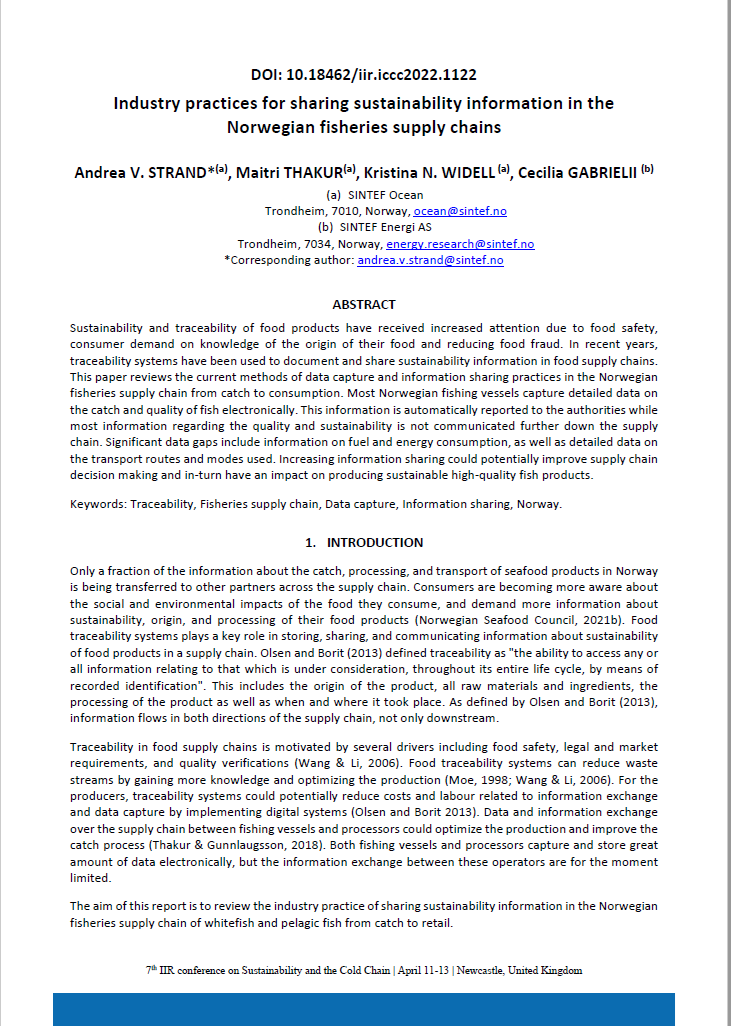
Report:
Industry practices for sharing information in the Norwegian fisheries supply chains
- Many fishing vessels and fish processors are using electronic systems and capture data automatically. However, most information regarding quality is not shared in the supply chain.
- Increasing the amount of data recorded and shared in the fisheries supply chain could increase quality of the seafood products as well as reducing the emissions.
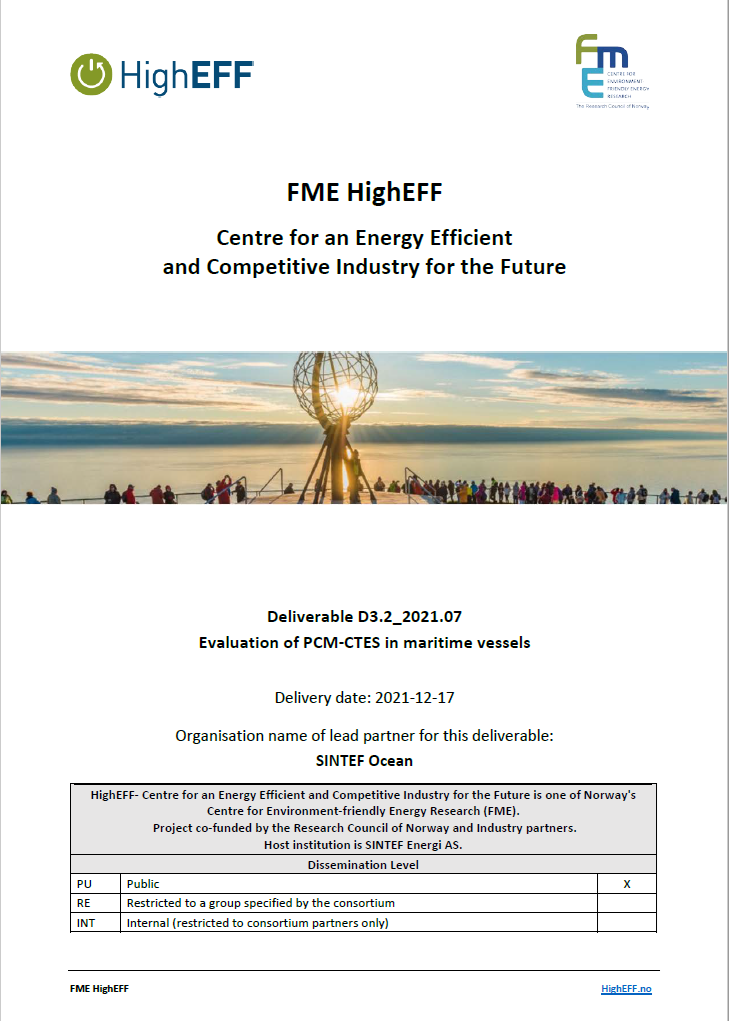
Report:
Evaluation of PCM-CTES in maritime vessels
- This report explores the possible benefits of peak shaving and energy saving using cold thermal energy storage.
- Current available thermal energy storage solutions are evaluated, with a particular focus on ice slurry systems. Studies show these systems could reduce cooling time without significant damage to the fish's surface.
- Also, some theoretical system configurations involving low-temperature phase change materials and cold recovery from liquid natural gas were discussed.
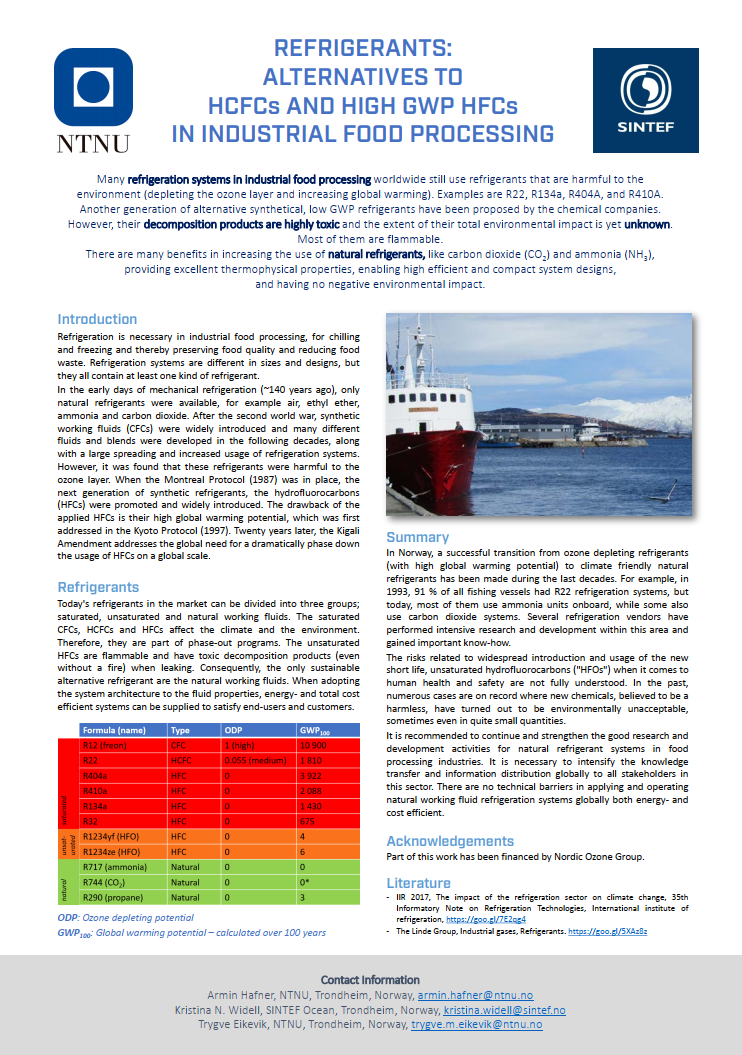
Informatory poster:
Alternative refrigerants to HCFCs and high-GWP HFCs in industrial food processing
- Many refrigeration systems in industrial food processing worldwide still use refrigerants that are harmful to the environment. Examples are R22, R134a, R404A, and R410A.
- Another generation of alternative synthetical, low GWP refrigerants have been proposed by the chemical companies. However, their decomposition products are highly toxic and the extent of their total environmental impact is yet unknown. Most of them are flammable.
- There are many benefits in increasing the use of natural refrigerants, like carbon dioxide (CO2) and ammonia (NH3), providing excellent thermophysical properties, enabling high efficient and compact system designs, and having no negative environmental impact
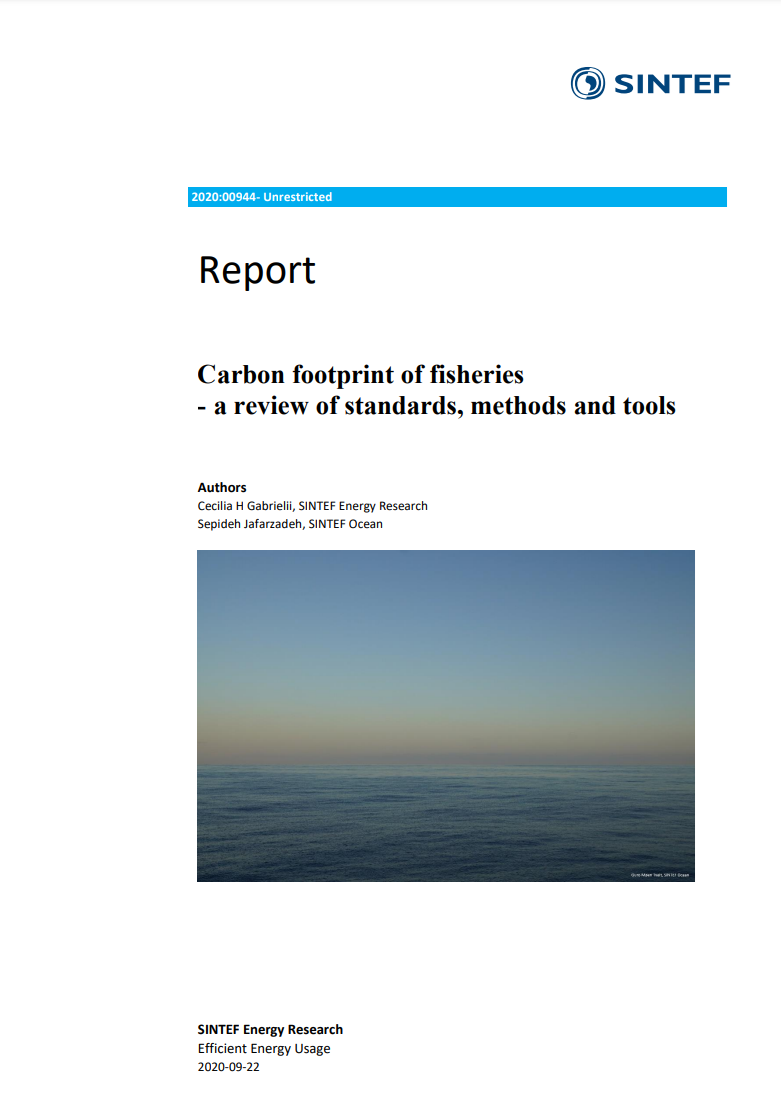
Report:
Carbon footprint of fisheries - a review of standards, methods and tools
- For captured seafood products the fishing vessel's fuel consumption is dominating the carbon footprint. The fuel intensity largely depends on fishing method, abundance of stocks, distance to fishing grounds, and type of on-board refrigeration and processing systems.
- There are various methods, tools, guide-lines and certification schemes available for carbon footprint assessments of seafood. However, there is a need for further standardisation to enable accurate comparisons of various seafood products.
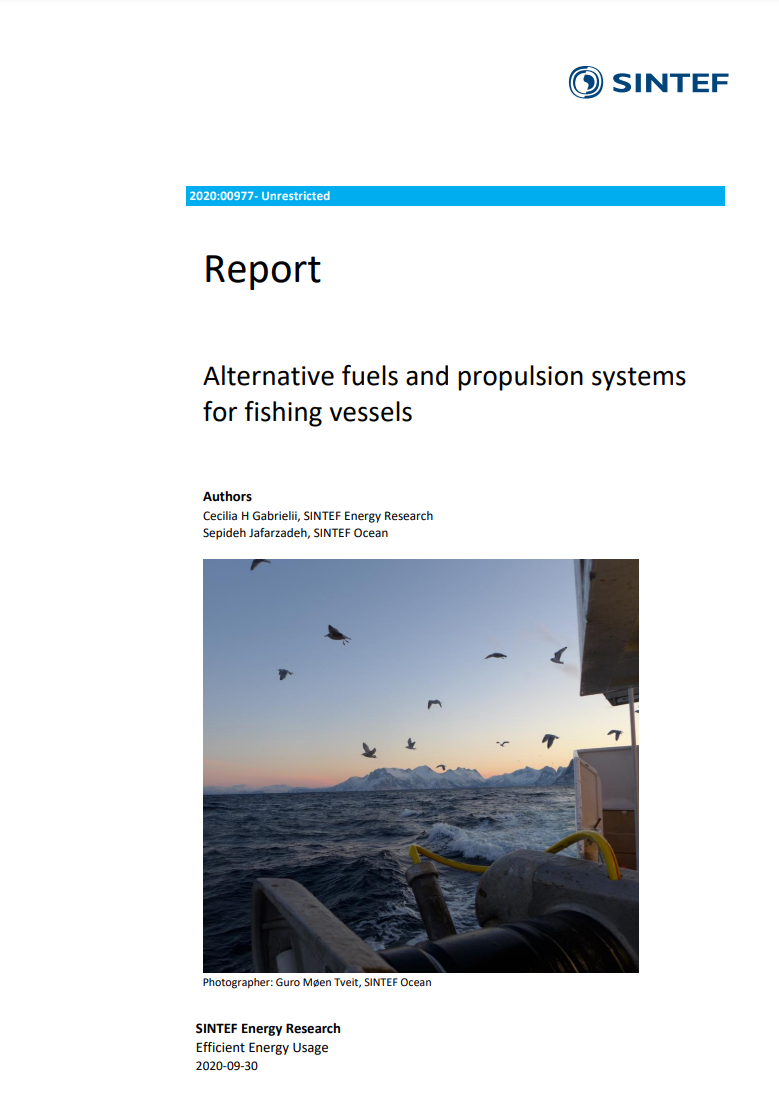
Report:
Alternative fuels and propulsion systems for fishing vessels
- In Norway there is a development towards hybrid propulsion systems, including batteries. The use of LNG or biofuel as alternative fuel in combustion engines and the use of hydrogen or ammonia in fuel cells is feasible on a short- and medium term perspective, respectively.
- The implementation of hybrid propulsion, and alternative fuels, enable fuel-efficient, low-emission and flexible operation. However, it implies challenges in relation to use of waste heat for covering thermal demands, and to proper sizing and operation of heating and cooling equipment.
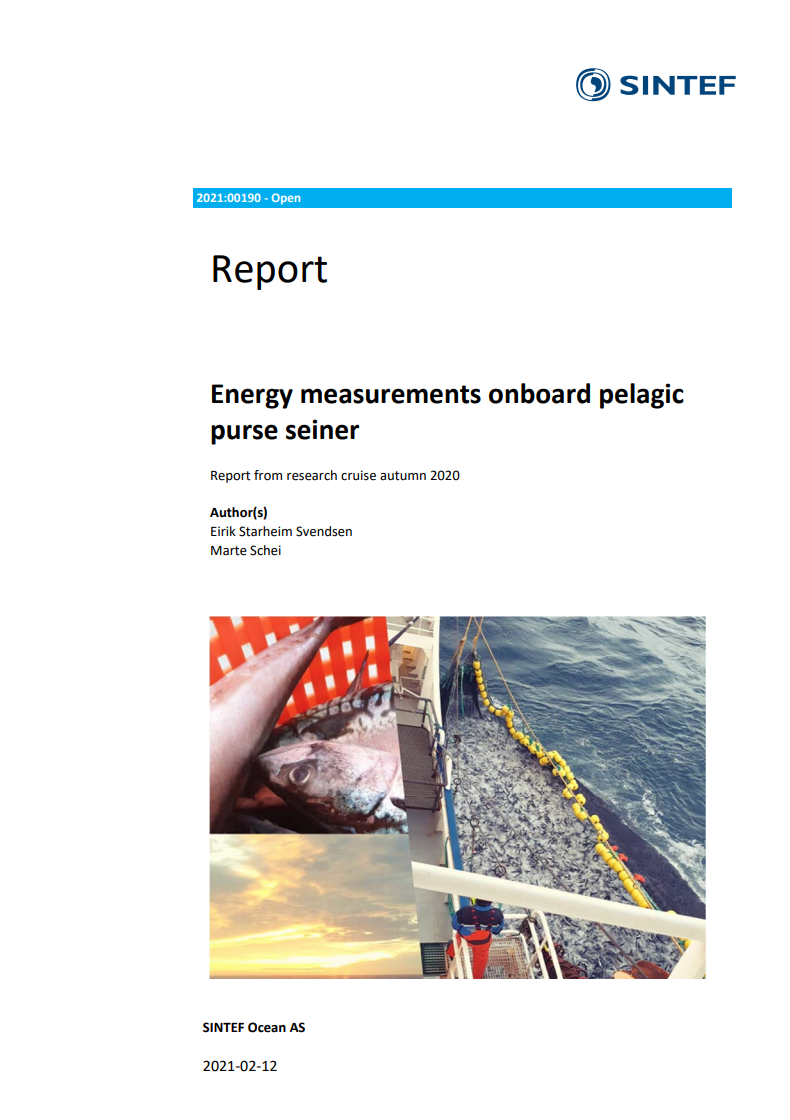
Report:
Energy measurements on board pelagic purse seiner
- This report describes a research cruise carried out on a pelagic purse seiner during the autumn of 2020 on the North Sea, with an overall goal to perform an energy efficiency assessment of the onboard RSW system
- Efficiency of the onboard cooling is heavily connected with operational modus of the vessel and RSW system, i.e. steaming to and from fishing grounds, pre-chilling of seawater, chilling of catch and maintenance chilling
- Lowest efficiency was measured during maintenance chilling periods, which for this cruise was the periods with most operational hours. Efficiency measures should be targeted towards this mode.
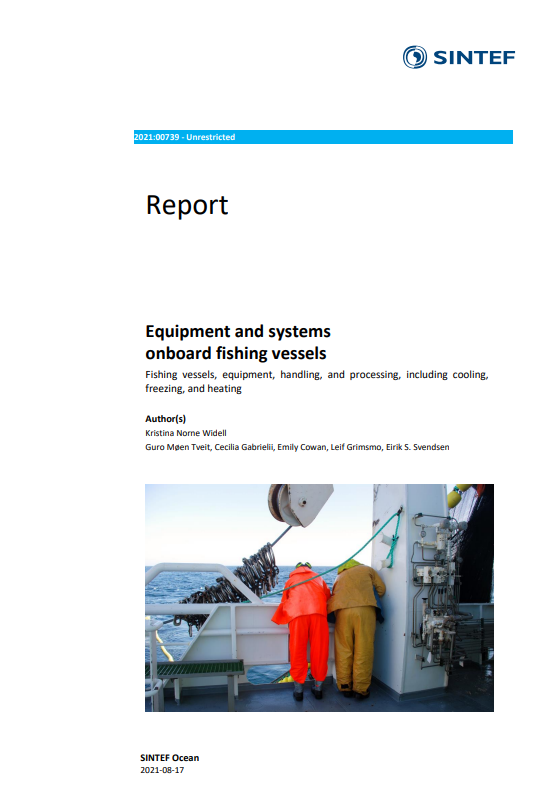
Report:
Equipment and systems onboard fishing vessels
- The Norwegian fleet consists of fishing vessels ranging from small boats to large factory trawlers
- Different fishing methods, gear and processing equipment is described
- Energy saving methods are proposed and issues related to sustainability are described
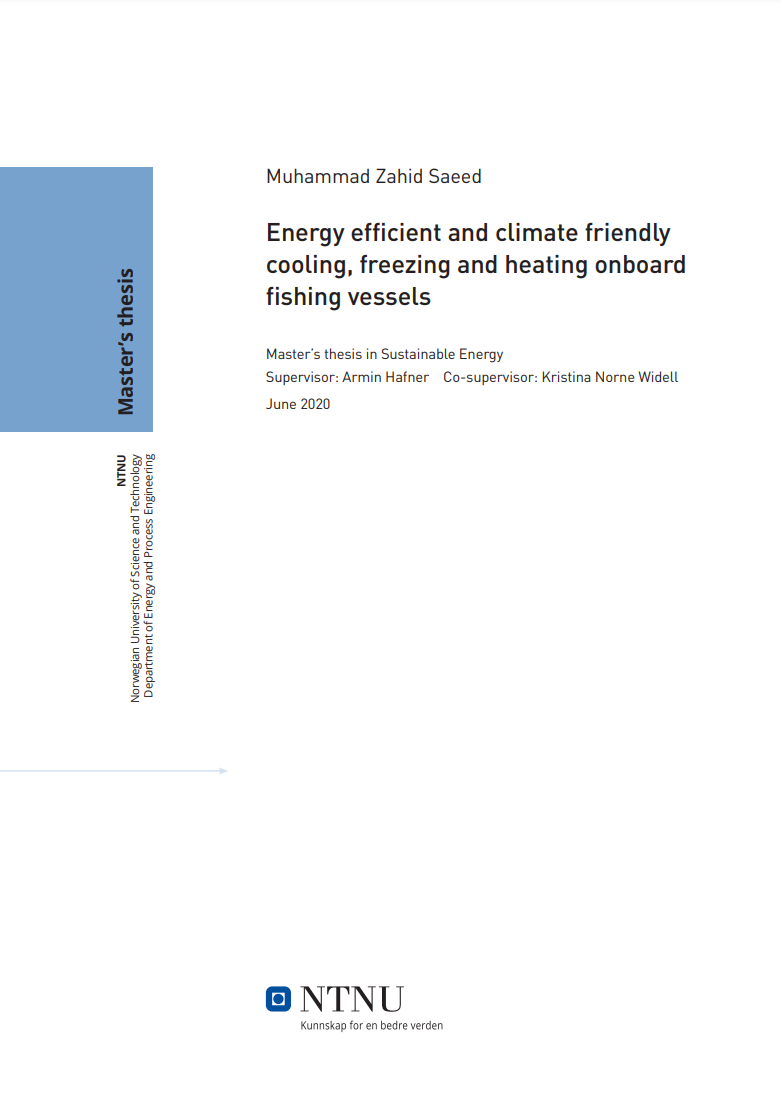
Master thesis:
Energy efficient and climate friendly cooling, freezing and heating onboard fishing vessels
- The fishing fleet of Norway consists of different types of vessels, ranging from small boats to large fish factories, with a total number of more than 6000 vessels. All vessels have methods for keeping the fish cold to preserve fish quality and shelf life
- Fishing vessels are in a transition from heavy hydrocarbon fuels and synthetic refrigerants to environment-friendly solutions. Liquified natural gas (LNG) as fuel is one of the potential solutions as it emits 90% less NOx, 24% less CO2 and almost no SOx compared to existing fuels.
- The master thesis work has developed a simulation platform to be able to analyse the impact and performance of different energy system configurations onboard with natural refrigerant CO2 and LNG as fuel
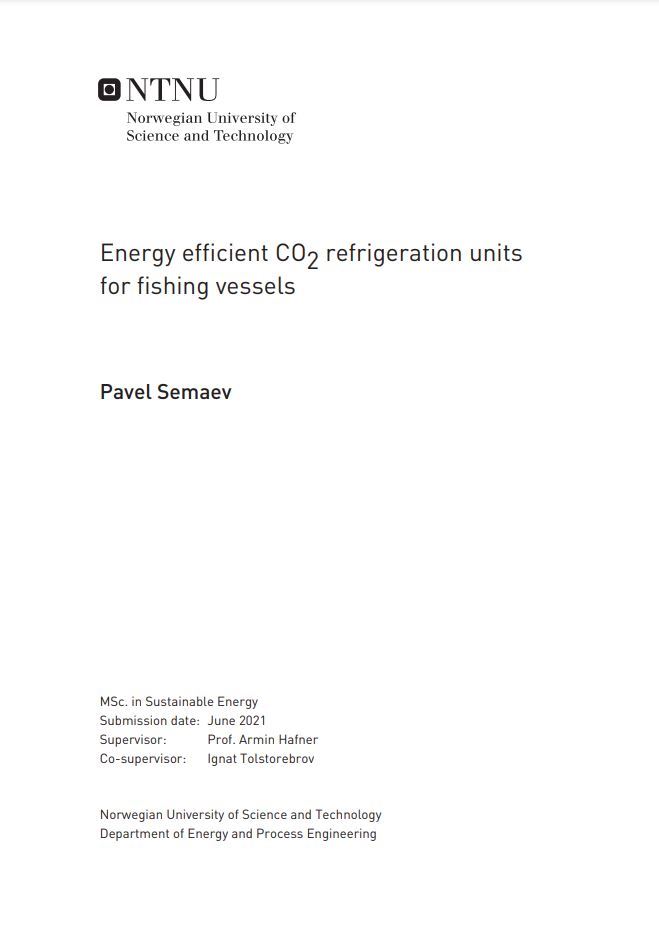
Master thesis:
Energy efficient CO2 refrigeration units for fishing vessels
- This thesis describes the architecture and performance of a prototype industrial CO2 transcritical system for refrigerated seawater.
- The CO2 system will cover cooling demands for air conditioning, refrigerated seawater, and low-temperature freezing.
- Five simulation models for the CO2 system were developed using Engineering Equation Solver (EES) and Dymola/Modelica.
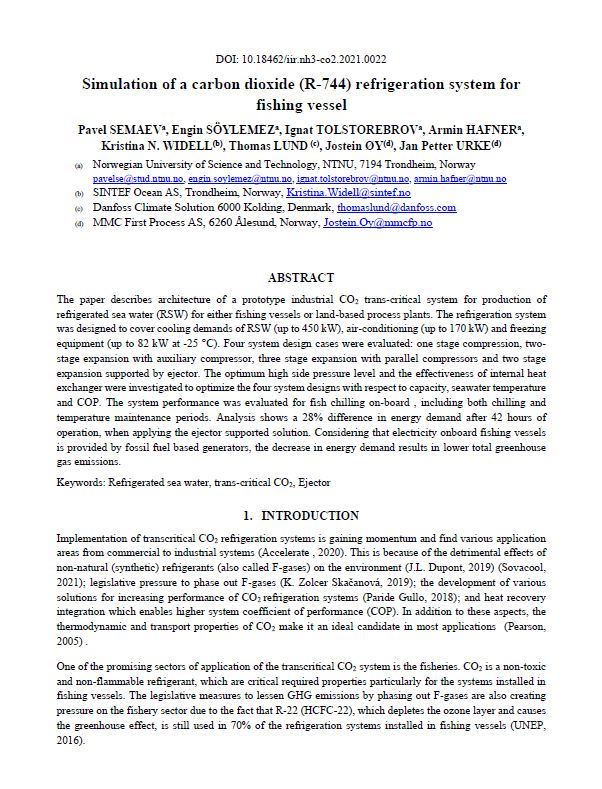
Conference paper:
Simulation of a carbon dioxide (R-744) refrigeration system for
fishing vessel
- This is a short version of the master thesis by Pavel, with selected results
- The paper describes the architecture of a prototype industrial CO2 trans-critical system for refrigerated seawater (RSW) production for either fishing vessels or land-based process plants. The refrigeration system was designed to cover the cooling demands of RSW (up to 450 kW), air-conditioning (up to 170 kW), and freezing equipment (up to 82 kW at -25 °C).
- Four system design cases were evaluated: one stage compression, two-stage expansion with auxiliary compressor, three-stage expansion with parallel compressors, and two-stage expansion supported by an ejector
- The optimum high side pressure level and the effectiveness of an internal heat exchanger were investigated to optimize the four system designs concerning capacity, seawater temperature, and COP.
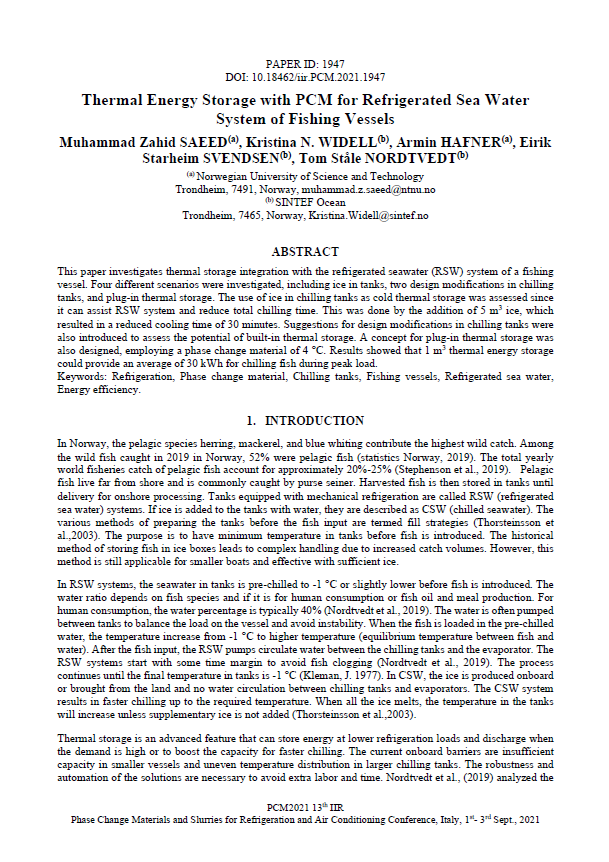
Conference paper:
Thermal Energy Storage with PCM for Refrigerated Sea Water System of Fishing Vessels
Abstract:
- Four different scenarios were investigated, including ice in tanks, two design modifications in chilling tanks, and plug-in thermal storage. The use of ice in chilling tanks as cold thermal storage was assessed since it can assist RSW system and reduce total chilling time. This was done by the addition of 5 m3 ice, which resulted in a reduced cooling time of 30 minutes.
- Suggestions for design modifications in chilling tanks were also introduced to assess the potential of built-in thermal storage. A concept for plug-in thermal storage was
also designed, employing a phase change material of 4 °C. Results showed that 1 m3 thermal energy storage could provide an average of 30 kWh for chilling fish during peak load.
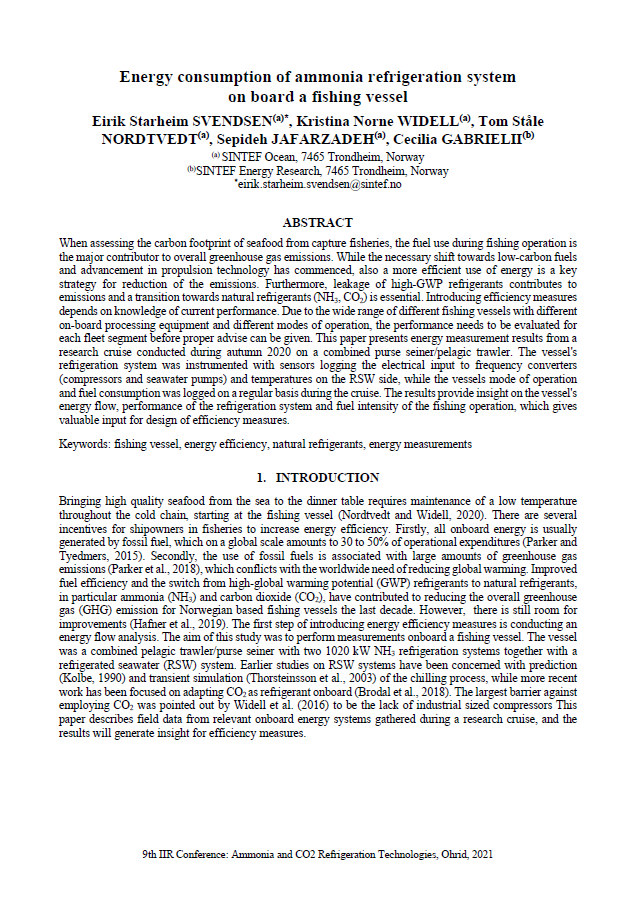
Conference paper:
Energy consumption of ammonia refrigeration system on board a fishing vessel
Abstract
- This paper presents energy measurement results from a research cruise conducted during autumn 2020 on a combined purse seiner/pelagic trawler.
- The vessel's refrigeration system was instrumented with sensors logging the electrical input to frequency converters (compressors and seawater pumps) and temperatures on the RSW side, while the vessels mode of operation and fuel consumption was logged on a regular basis during the cruise.
- The results provide insight on the vessel's energy flow, performance of the refrigeration system and fuel intensity of the fishing operation, which gives valuable input for design of efficiency measures.
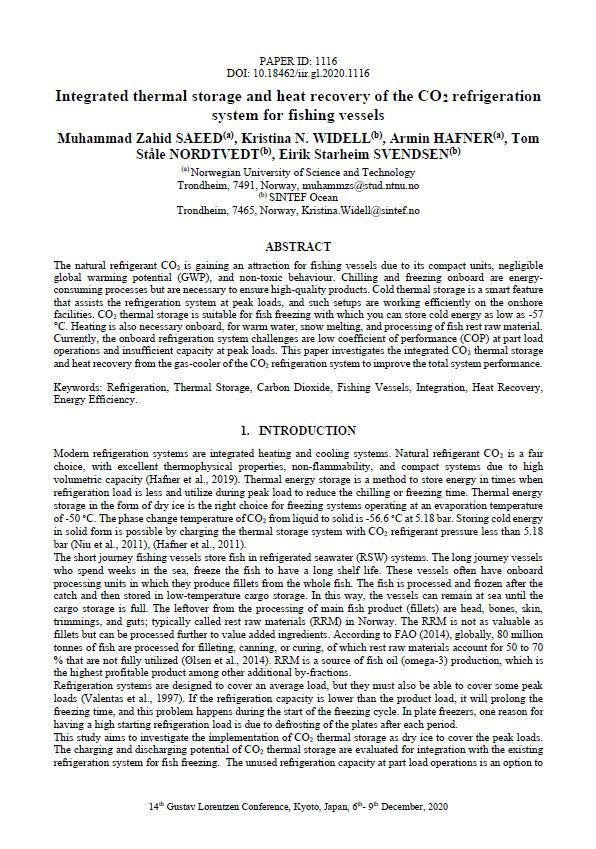
Conference paper:
Integrated thermal storage and heat recovery of the CO2 refrigeration system for fishing vessels
- This paper is a cold thermal storage explored to assist the refrigeration system at peak freezing loads. The integrated thermal storage is a Co2 based system with a capacity of 50 kWh. The system reduces the peak freezing time from 10 to 8 minutes, with 28 peaks per day, giving the system an additional production capacity of 56 minutes per day.
- Heat recovery from the gas cooler was used to fish oil production
- Dynamic simulations were modelled in Dymola with libraries from TIL.
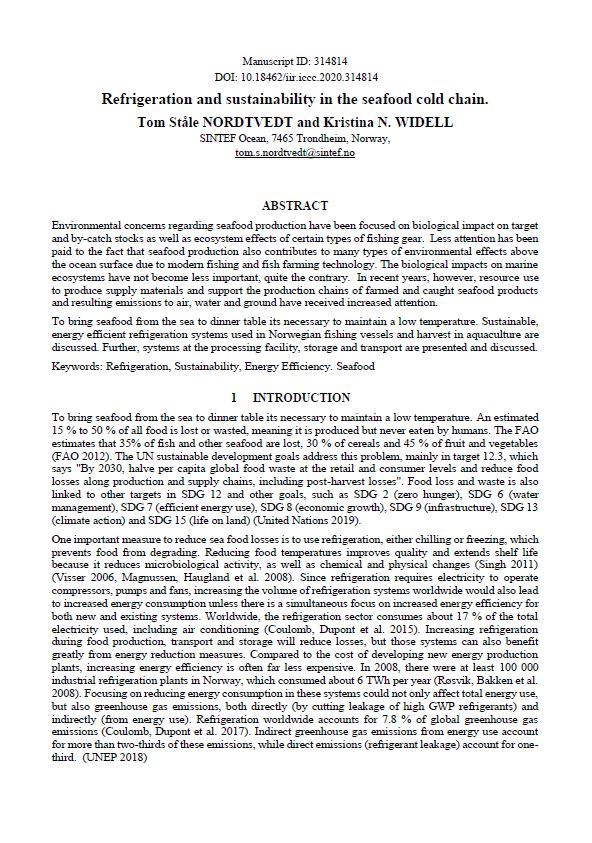
Conference paper:
Refrigeration and sustainability in the seafood cold chain
- The sustainability in the seafood is discussed concerning the environmental effects above the ocean surface
- Parts of the cold chain are explored, such as refrigeration after harvest at sea, seafood farming, seafood processing, and transport.
- The sustainability of the seafood value chain is compared through the product's carbon footprint.
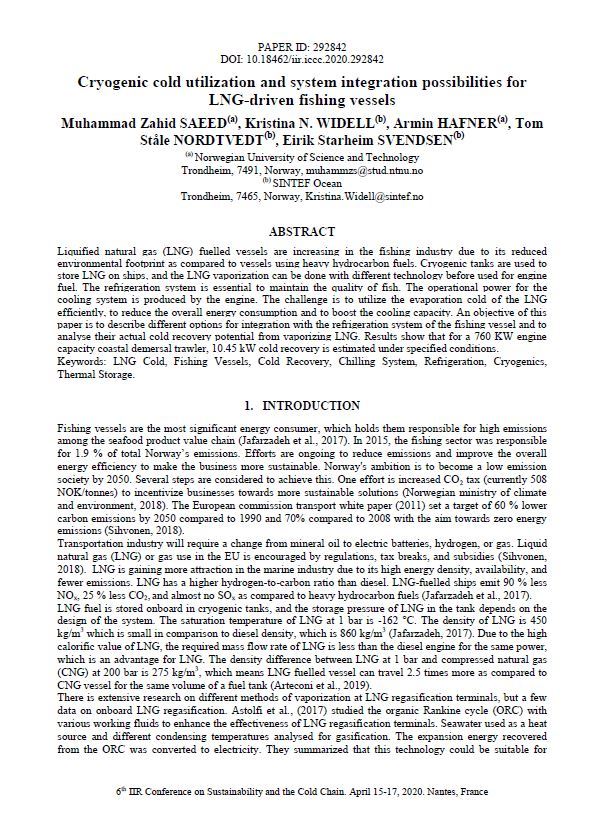
Conference paper:
Cryogenic cold utilization and system integration possibilities for
LNG-driven fishing vessels
- The saturation temperature of LNG at 1 bar is -162 °C, and during regasification could the cold in the LNG be used to assist the refrigeration system.
- This paper discusses several methods to utilize the cold, i.e. sub-cooling of refrigerant, direct chilling of fish tank, and thermal storage
- A steady-state thermodynamic analysis of the LNG cold recovery was performed on Aspen HYSYS V10.